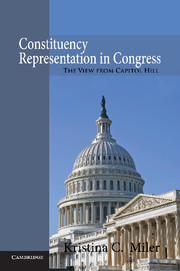Book contents
- Frontmatter
- Contents
- Acknowledgments
- 1 The Unanswered Question of Legislative Perceptions
- 2 A Dyadic Theory of Subconstituency Representation
- 3 The Psychology of Constituency Representation
- 4 Subconstituents Relevant to Health Policy and Natural Resources Policy
- 5 Explaining Legislative Perceptions
- 6 The Effects of Legislative Perception on Participation
- 7 Reassembling the District as a Whole
- 8 Perception, Reform, and Representation in Congress
- Appendix A Sampling
- Appendix B Interviews
- Appendix C Measurement of Primary Independent Variables
- Appendix D Measurement of Legislative Participation
- Appendix E Instrumental Variables Model of Legislative Participation
- References
- Index
7 - Reassembling the District as a Whole
Published online by Cambridge University Press: 05 October 2010
- Frontmatter
- Contents
- Acknowledgments
- 1 The Unanswered Question of Legislative Perceptions
- 2 A Dyadic Theory of Subconstituency Representation
- 3 The Psychology of Constituency Representation
- 4 Subconstituents Relevant to Health Policy and Natural Resources Policy
- 5 Explaining Legislative Perceptions
- 6 The Effects of Legislative Perception on Participation
- 7 Reassembling the District as a Whole
- 8 Perception, Reform, and Representation in Congress
- Appendix A Sampling
- Appendix B Interviews
- Appendix C Measurement of Primary Independent Variables
- Appendix D Measurement of Legislative Participation
- Appendix E Instrumental Variables Model of Legislative Participation
- References
- Index
Summary
In representing the various subconstituents in their districts, legislators often cannot avoid taking a larger view and thinking of “the district” as a collective. However, the district legislators see from Capitol Hill is not a perfect reflection of the objective reality of their district, but rather some filtered summary. This chapter identifies the legislator's perception of the district as a whole and examines its effects on his behavior. Given the evidence about the impact of perceptions of subconstituencies in Chapter 6, there is good reason to expect that the way legislators see the totality of their district also will affect their actions on Capitol Hill. The primary question explored in this chapter, then, is how these aggregate perceptions shape legislators' involvement at earlier and later stages of the lawmaking process.
Overall perceptions of the district are characterized by two important features: their completeness and their balance. Completeness of a district perception emphasizes the extent to which legislators perceive all subconstituency interests in the district relevant to the policy in question. The balance of district perception, on the other hand, shifts attention to the competing preferences among district interests. As this chapter shows, these two characteristics of perceptions are consequential. Legislators who perceive a more complete district are more active in introducing legislation than their colleagues with a narrower vision. Moreover, legislators who perceive a balanced district are not hesitant to sponsor legislation, despite the conventional wisdom that legislators representing competing constituents will be less active.
- Type
- Chapter
- Information
- Constituency Representation in CongressThe View from Capitol Hill, pp. 131 - 150Publisher: Cambridge University PressPrint publication year: 2010



